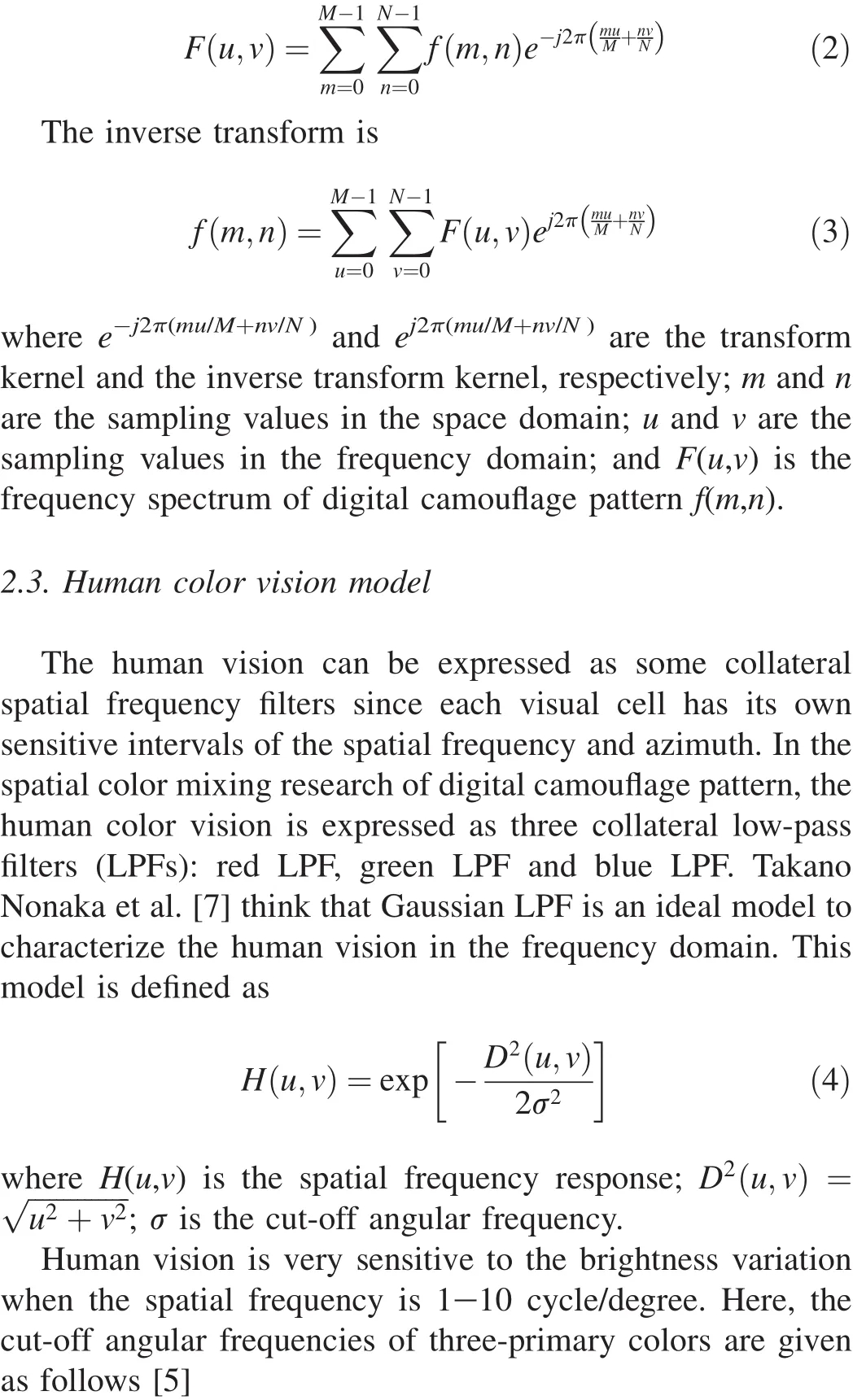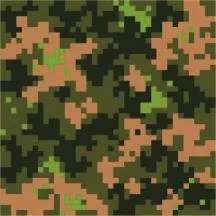The Spatial Color Mixing Model of Digital Camouf l age Pattern
2013-07-25YongZHANGShiqiangXUEXiaojunJIANGJingyangMUYangYI
Yong ZHANG*,Shi-qiang XUE,Xiao-jun JIANG,Jing-yang MU,Yang YI
The Spatial Color Mixing Model of Digital Camouf l age Pattern
Yong ZHANG*,Shi-qiang XUE,Xiao-jun JIANG,Jing-yang MU,Yang YI
Wuxi First Scientif i c Research Institute,Wuxi 214035,China
A spatial color-mixing model based on tricolor angular frequencies is proposed in consideration that the design theory falls behind the application of digital camouf l age pattern.The model is based on Fourier transform and Gaussian low-pass f i lter(LPF).In the model,the tricolor angular frequencies are introduced to the spatial frequency response function of human color vision,and the effects of atmospheric attenuation and air screen brightness on color mixture are considered.The f i eld test shows that the model can simulate the color-mixing process in the aspects of color-mixing order,and shape and position of color-mixing spot.But the color-mixing spot color is not perfect,which can be improved by optimizing the atmospheric parameters and tricolor cut-off angular frequencies.The model provides a tool for the research on digital camouf l age pattern.
CopyrightⒸ2013,China Ordnance Society.Production and hosting by Elsevier B.V.All rights reserved.
Digital camouf l age pattern;Spatial color mixing;Angular frequency;Gauss low-pass f i lter;Camouf l age
1.Introduction
Digital camouf l age pattern design is based on the spatial color mixing,which can signif i cantly improve the camouf l age effectiveness[1,2].However,the spatial color mixing research is still in the exploring stage[3,4],which can’t satisfy the requirements of digital camouf l age pattern design.A mathematical model of quantitatively researching the spatial colormixing process of digital camouf l age pattern is proposed in the paper.In the model,the human color vision is characterized by using Gaussian low-pass f i lter based on tricolor angular frequency[5],and the air screen brightness and atmospheric attenuation are considered.The model was validated in f i eld test.The model provides a tool for the research on digital camouf l age pattern,which is very important to the digital camouf l age pattern design.
2.Spatial color mixing model
2.1.Summary
The spatial color mixing effect of digital camou fl age pattern is affected by three factors:digital camou fl age pattern; atmosphere transmission,including atmosphere attenuation and air screen brightness;and human vision.Because the perception of human eye to the spatial color mixing effect of digital camou fl age pattern is a complex process of information transfer,reception and processing,the research method of signal detection is used to characterize the spatial color mixing process.
Assuming that a digital camou fl age pattern is expressed as f(m,n),which is composed of three channels R(m,n),G(m,n) and B(m,n).Firstly,the digital camou fl age pattern is adjusted by atmosphere attenuation and air screen brightness.Secondly, the adjusted pattern is transformed from space domain to frequency domain by Fourier transform,and then the pattern is fi ltered using the spatial frequency response function of humancolor vision.At last,the resulting pattern is transformed by inverse Fourier transform.By now,the spatial color mixing result of the original pattern can be obtained.This model could be expressed as

where g(m,n)is the color mixing pattern;α is the brightness coeff i cient of air screen;T(τ,d)is the atmospheric transmissivity characterizing the atmospheric attenuation;and H(u,v)is the spatial frequency response function of human color vision.
2.2.Fourier transform of digital camouf l age pattern
Fourier transform is usually used for digital image processing.Since the characteristics of human color vision are considered as spatial frequency responses function of color here,the digital pattern must be transformed from the space domain to frequency domain by using Fourier transform. Supposing that the size of digital camouf l age pattern is M×N, the 2D discrete Fourier transform is def i ned as[6]


It can be seen from Eq.(6)that the viewing distance d is the independent variable of human vision function,which may affect the pattern color mixing result.
2.4.Atmosphere transmission
When you observe the digital camouf l age pattern,the atmosphere would affect the pattern brightness.This effect is ref l ected in two aspects:one is that the atmosphere makes the pattern brighter by scattering some solar radiation to the viewing path,enhancing the pattern brightness;the other is that the atmosphere makes the pattern darker by absorbing and dispersing some solar radiation in the viewing path.The effect of air screen brightness on the pattern brightness is described by

3.Field test
Fig.1 shows the digital camouf l age pattern under test.The brightnesses of dark green(in web version),median green(in web version),emerald green(in web version)and ochre spots(Lab color space)are 12,33,63 and 62,respectively.The test procedure is
(a)to select a rigid cardboard,and then print the sample pattern on it;
(b)to place the rigid cardboard with pattern in the vegetation, which is perpendicular to the ground and the optical axis of digital camera(Fig.2);
(c)to shoot the scene with the cardboard at different distances by using the digital camera;
(d)to choose the digital camouf l age pattern from the screen images to obtain the real color mixing pattern;
(e)to process the sample pattern by the proposed spatial color
mixing model to calculate the virtual color mixing pattern; (f)to compare and analyze the real and virtual color mixing
patterns.
During test,the sky is clear,the solar altitude is about 50°, the angle between the optical axis of camera and the direction of sun light is about 30°,the visibility rank is 9;the basic cell of digital pattern is 5 cm×5 cm;the interval of shooting distance is 5 m,the focal length of camera is f i xed to 20 mm; the printer is HP5100,the digital camera type is Canon 5000. Fig.3 shows the real color mixing patterns which were taken at 10 m,20 m and 30 m,respectively.Fig.4 shows the virtual color mixing patterns,the air screen brightness coeff i cient α∈(1.0,1.5)and the atmosphere transmissivity τ∈(0,0.078).

Fig.1.Sample digital pattern.

Fig.2.Color mixing scene.

4.Result analysis
The real and virtual color mixing patterns are compared and analyzed from the aspects of the color-mixing order,the color-mixing spot color,and the color-mixing spot shape and position.
(1)Color-mixing order
The color-mixing order is researched in the color mixing process.In Fig.3(a),the dark green and median green spotswith low brightness on the pattern taken at the distance of 10 m are not still mixed;In Fig.3(b),the dark green and median green spots on the pattern taken at the distance of 20 m are completely mixed,and the emerald green and ochre spots begin to be mixed;In Fig.3(c),the emerald green and ochre spots on the pattern taken at the distance of 30 m,are completely mixed.The spots on the digital pattern are lastly mixed into two kind spots with different brightness:one is the darker spots obtained from the dark green and median green spots;the other is the brighter spots obtained from the emerald green and ochre spots.
The color mixing process in Fig.4 is similar to that in Fig.3.With the increase in virtual viewing distance,the dark green and median green spots with lower brightness are mixed fi rstly,then the emerald green and ochre spots with higher brightness and less difference are mixed,and the darker spots and lighter spots come into being lastly.Compared with the real and virtual color mixing patterns,the color mixing processes of dark green and median green spots are similar,but there are the differences in the color mixing processes of emerald green and ochre spots:the viewing distances of similar color mixing patterns are different.In Fig.3(b),the emerald green and ochre spots are mostly mixed,but in Fig.4(b),this process begins just now.The viewing distance difference is probably related to the atmosphere parameters which should be optimized by fi eld test.
The orders of virtual and real color-mixing are similar, which are affected by the brightness and brightness differences of spots,moreover,the latter is more important.(2)Color-mixing spot color.

Fig.4.Color mixing patterns taken at different virtual distances(a)10 m(b) 20 m(c)30 m.

Fig.5.The colors of real and virtual color-mixing spots(the viewing distance of 20 m)(a)Real color-mixing pattern(b)Virtual color-mixing pattern.
The colors of color-mixing spots are analyzed through visual observation.The color difference between real and virtual color mixing spots is less in the whole pattern,but there is theobvious differences in the local pattern:the purple spots exist in the edge of brighter spots on virtual pattern,particularly in the corner of spots;some brighter yellow spots are dispersed in the virtual color mixing pattern,particularly in the ochre spots, as shown in Fig.5.The above-mentioned cases are related to two factors without decreasing the image sampling precision: atmosphere parameter and tricolor cut-off angular frequency. These factors need be optimized through f i eld test.
The color difference between the real and virtual colormixing spots could be found by human vision,which can be improved by optimizing the atmosphere parameters and the cut-off angular frequencies without decreasing the image sampling precision.
(3)Shape and position of color-mixing spot
The shape and position of color-mixing spot are analyzed through visual observation,too.It can be seen from Figs.3 and 4 that the shapes of virtual and real color-mixing spots are similar and their positions are the same at same viewing distances.This indicates that the proposed model can be used to simulate the real color mixing processes.Fig.6 shows that the edges of virtual color mixing spots are fuzzy and the visual contour is not clear.This is related to the tricolor cut-off angular frequencies,which can be optimized through f i eld test.
The shapes and positions of real and virtual color-mixing spots are similar.If we can make the color mixing spots contour clearer by optimizing the tricolor cut-off angular frequencies,the result will be better.
In a word,the spatial color mixing model of digital camouf l age pattern was validated by the f i eld test.This model can be used to simulate the real color mixing process in the colormixing order,and the shape and position of color-mixing spot. But the color-mixing spot color needs to be improved.
In addition,the digital camera is used instead of human eye in this test,which could affect the f i eld test result to some extent for difference between digital camera and human eye.

Fig.6.The shapes and positions of real and virtual color-mixing spots(the viewing distance of 20 m)(a)Real color-mixing pattern(b)Virtual colormixing pattern.
5.Conclusions
As a new camouf l age pattern,the digital camouf l age pattern has been used for moving and f i xed military targets,but the design theories and the camouf l age effectiveness evaluation methods for it are few.A spatial color mixing model based on tricolor angle frequency was proposed,which was validated through the f i eld test.The model can be not only used for the design of digital camouf l age pattern and the evaluation of camouf l age effectiveness,but also for the research of camouf l age net and decoy.
[1]Hu JH.Camouf l age technology.Beijing:National Defense Industry Press; 2012[in Chinese].
[2]Yu J,Xiao S.Design of imitation digital camouf l age.J Appl Sci 2012;30(4):331-4[in Chinese].
[3]Nonaka T,Matsuda M,Hase T.Color mixing simulator for display surfaces based human color vision.In:Proceedings 21st European conference on modelling and simulation.Ivan Zelinka:ECMS;2007.
[4]Zhao XM,Shao XP,Zhang JQ,Zhou Xiaoyuan.Objective assessment of the color errors in RGB undersampled images based on color blending of multi-scale region.J Electron Inf Technol 2012;34(9):2071-7[in Chinese].
[5]Kurahashi K.Visual color shifts in spatial array of three primary colors.J Inst Telev Eng Jpn 1986;40(5):392-7[in Japanese].
[6]Wang AL,Ye MS,Qiuxiang Deng.Matlab 2007 image processing technology and application.Beijing:Publishing House of Electronics Industry; 2008[in Chinese].
[7]Nonaka T,Matsuda M,Hase T.Color mixture model based on spatial frequency response of color vision.In:IEEE international conference on systems,man,and cybernetics.Taipei:IEEE;2006.
[8]Wu J,Yang CP,Liu Jianbin.The light transformation theory in atmosphere.Beijing:Beijing University of Posts and Telecommunications Press;2005[in Chinese].
18 April 2013;revised 8 July 2013;accepted 28 August 2013 Available online 5 October 2013
*Corresponding author.
E-mail address:c14518@163.com(Y.Zhang).
Peer review under responsibility of China Ordnance Society
Production and hosting by Elsevier
2214-9147/$-see front matter CopyrightⒸ2013,China Ordnance Society.Production and hosting by Elsevier B.V.All rights reserved. http://dx.doi.org/10.1016/j.dt.2013.09.015
杂志排行
Defence Technology的其它文章
- The Research on Compressive Properties of Polytetraf l uoroethylene at High Strain Rate
- Research on Key Technologies of Detecting 1553B Avionics Data Bus Network
- Application of Space-time Conservation Element and Solution Element Method in Intake and Exhaust Flows of High Power Density Diesel Engine
- Research on Optical Properties and Micro-processing Characteristics of Collodion Thin Film
- Design Method of Equipment Optimization Development Based on Standardization Theory
- First-principles Study of Electronic Structures,Elastic Properties and Thermodynamics of the Binary Intermetallics in Mg-Zn-Re-Zr Alloy
